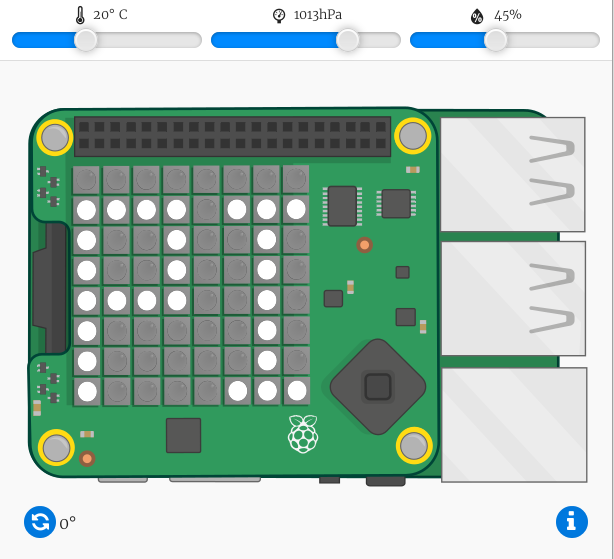
- #SENSE HAT EMULATOR FOR MAC INSTALL#
- #SENSE HAT EMULATOR FOR MAC CODE#
- #SENSE HAT EMULATOR FOR MAC PLUS#
- #SENSE HAT EMULATOR FOR MAC FREE#
- #SENSE HAT EMULATOR FOR MAC WINDOWS#
Fine, I’ll build my own package repository…Īfter solving the one-time space problem for Dave, I considered whether a more permanent, automated solution was possible. There’s a project on GitHub where a member of the Pi community has documented how you build tensorflow, and he distributes the wheel. An example of this is tensorflow: 12 wheels, no source. But if you’re on ARM, there’s no source to fall back to, so you can’t even build it yourself. That’s fine if you’re on an Intel machine, there’ll probably be a matching wheel for your architecture. What’s worse is when packages only provide wheels. What? This is an outrage! Don’t the maintainers of PyPI care about Raspberry Pi users? There’s an architecture tag whitelist, and it’s not on the list. Well, even if they did, they can’t do anything about it because PyPI doesn’t allow uploading ARM wheels. What? This is an outrage! Don’t the maintainers of numpy care about Raspberry Pi users? But there’s no wheel matching your architecture: you’re not manylinux_x86, manylinux_x86_64, or any of the others.
#SENSE HAT EMULATOR FOR MAC INSTALL#
When you type pip install numpy, the flow goes like this: Building numpy on a Raspberry Pi 1 takes about 2 hours 30 minutes.Building numpy on a Raspberry Pi 3 takes about 20 minutes.When you build a wheel, the filename is made up of a number of parts:
#SENSE HAT EMULATOR FOR MAC PLUS#
There are 22 wheels in total, plus the source zip. For example, numpy distributes wheels for many combinations of:įor each version of Python they support (2.7, 3.4, 3.5 and 3.6). Maintainers of popular packages like numpy which take a long time to build from source tend to provide wheels for a variety of common architectures. Not all package maintainers choose to distribute wheels at all, and those who do are likely to only provide wheels for architectures they have the means to build for. This does not apply to pure Python packages, which are tagged with architecture any.
#SENSE HAT EMULATOR FOR MAC WINDOWS#
a wheel built on Windows x86 will not work on a Windows x86_64 machine. However, wheels for packages implemented in C are architecture-specific: a wheel will only work on the architecture on which it was complied: e.g. If a wheel has been provided by the maintainer, then pip downloads the wheel (the built distribution) instead of the source distribution (a tarball or zip), and this speeds up the installation process. Wheels are pre-built binaries package maintainers can use to distribute pre-built versions of their packages to save users having to build packages themselves. A general solution to this exists: Python wheels. pip handles this for you, but it can sometimes take a long time to build a package.
#SENSE HAT EMULATOR FOR MAC CODE#
However, if (like numpy), the package is implemented in C, then you have to compile the C code and build it before you can install it. If the package is implemented in Python, this is usually quite quick. When you install a package from PyPI (the Python Package Index) using pip, for example pip install numpy, it downloads the package and installs it on your system.

It took 2 hours 30 minutes to build numpy alone. We had to build on a Pi 1 to get an ARMv6 tagged wheel.

As I said, these are Pi 1s, so they’re ARMv6. But since there was no way of excluding the libraries we already have available (without traversing the dependency tree and comparing manually), we just let it build them all. It took a long time, because some of the packages had their own dependency requirements. He said “is there a way we can install these libraries offline?” I said “Yes, I think you can build wheels for the libraries, and install from the wheel files”. The only thing we can do is provide ESA with files and instructions. The Pis are actually connected to the space station LAN, but not to the internet. He needed to be able to install new libraries on the Pis in space. They’d just finished a competition cycle, and some of the kids’ code had third-party library dependencies.


We run competitions for kids to write Python code on Raspberry Pis and Sense HATs in school (or in an emulator we provide) that gets run in space.Īnyway, my excellent colleague Dave, who runs the programme, asked me for help one day. They have Sense HATs (a particular sensor board we made especially for this mission) housed in space-grade aluminum cases. They went up with British ESA astronaut Tim Peake in 2015. If you didn’t already know, there are two Raspberry Pis on the International Space Station, as part of a programme we run called Astro Pi. I presented this project recently in a lightning talk at EuroPython. Background: I work for the Raspberry Pi Foundation and I do a lot of Python stuff on Raspberry Pi.
#SENSE HAT EMULATOR FOR MAC FREE#
The title may have given away the article contents, but feel free to read on pretending you don’t know the ending.


 0 kommentar(er)
0 kommentar(er)
